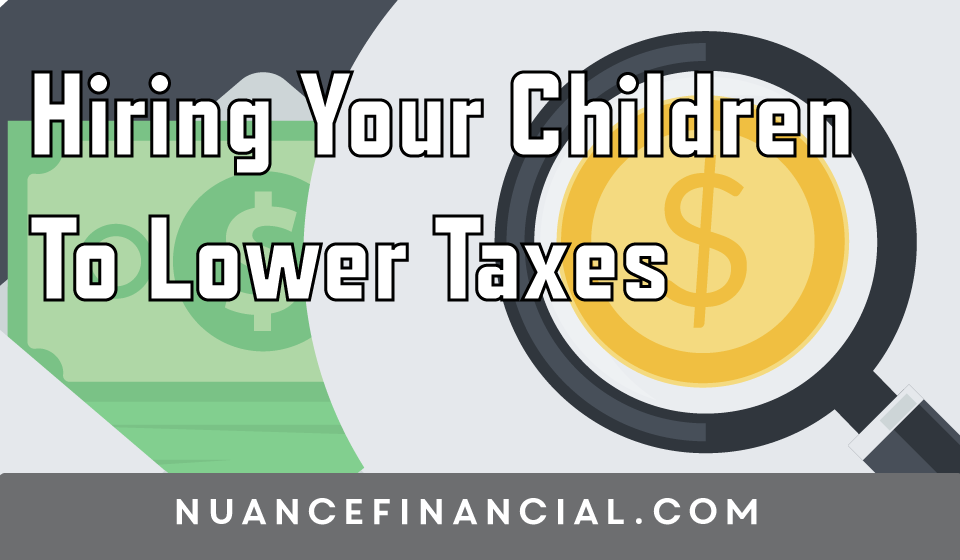As Minnesota Accountants and Lakeville CPA’s, we are always looking for ways that we can help Minnesota small business owners mitigate their income taxes, and reduce self employment taxes. One of the great ways to do this is to look at hiring your kids if they are under the age of 18, with a couple of caveats. The first is that you definitely want to connect with a Minnesota Accountant or Minnesota CPA like our very own Nick Meester from Nuance Financial. We help Minnesota small businesses focus on what they do best, by serving them as their outsourced accountants, bookkeepers, tax advisors, and payroll specialists. We’re Lakeville CPA’s and Minnesota Accountants that serve as an outsourced finance team to reduce your taxes and help you pay only your fair share in taxes.
But how can you know if hiring your kids can lower your taxes?
“Allowance” and other financial aid you extend to your children, grandchildren, or even parents is a deductible business expense if you pay them to perform bona fide work for your business and pay them reasonable compensation for that work.1 Of course, at that point, it isn’t allowance. It’s wages. If you’re hiring your kids, they might develop financial responsiblity at a much higher rate while you can benefit from lower taxes. ”
Important Notes about Hiring your Kids to lower taxes:
- Your child can earn up to the standard deduction for single taxpayers ($6,300 for 2015) before they owe tax on their income. The next $9,225 is taxed at just 10%. Earned income isn’t subject to the “kiddie tax” for children under 19 (or dependent full-time students under age 24).*2 Other family employees pay tax at their regular rate.
- The Tax Court approves wages for children as young as 7.*3
- Your family employee’s work should be directly related to your business.*4
- Pay your employee a reasonable wage for their age and the service they perform. Their wages should be similar to amounts paid for similar services by similar businesses under similar circumstances—with adjustments made for their age and experience.
- To verify your deduction and audit-proof your return, keep a timesheet showing the dates, hours, and services performed.*5 Pay your child by check, and deposit the check in an account in the child’s name. This can be a Roth IRA, Section 529 college savings plan, or custodial account. You can’t use custodial assets for your obligations of parental support; however, parental support doesn’t include “extras” like private or parochial school tuition, summer camps, and similar expenses.
- If your business is taxed as a proprietorship, you don’t owe Social Security or Medicare taxes on your child’s wages until they reach age 18.*6 You don’t owe unemployment tax until they reach age 21.*7 The same rule applies if your business is taxed as a partnership and you and your spouse own all partnership interests.
- Hiring family members to help work in your business also lets you establish employee benefit programs such as a medical expense reimbursement plan, education assistance plan, and retirement plans.
- Paying your young children, and subsequently investing that into a ROTH IRA provides great capabilities to build up massive compound interest (nothing is guaranteed). Since we are Minnesota Accountants and Lakeville CPA’s dedicated to serving small businesses, we regularly help coach clients to collaborate the hiring of their children with a sound investment strategy (Nuance Financial does not sell securities)
When answering the question “Can hiring your kids lower taxes?”:
Here’s a video about this strategy from Mark Koehler:
Pay your family employee’s wages the same as you would pay any other employee on Schedule C, Form 1065, or Form 1120. They should complete Form W-4for your records. File Form 941 (quarterly) or Form 944 (annually) to report any FICA or withholding taxes, Form 940 annually for unemployment taxes, plus any applicable state or local employment taxes. Finally, prepare a Form W-2 and file it, along with Form W-3, annually. (If this sounds like a hassle, introduce your child to the joys of bureaucracy by having them manage their payroll!)
IRS Publication 15:
Circular E, Employer’s Tax Guide
Sources:
1Rev. Rul. 73-393.
2IRC §1(c).
3Eller v. Comm’r, 77 TC 934.
4Denman v. Comm’r, 48 TC 439 (1967).
5Regs §1.162-7(a).
6IRC §3121(b)(3).
7IRC §3306(c)(5).


